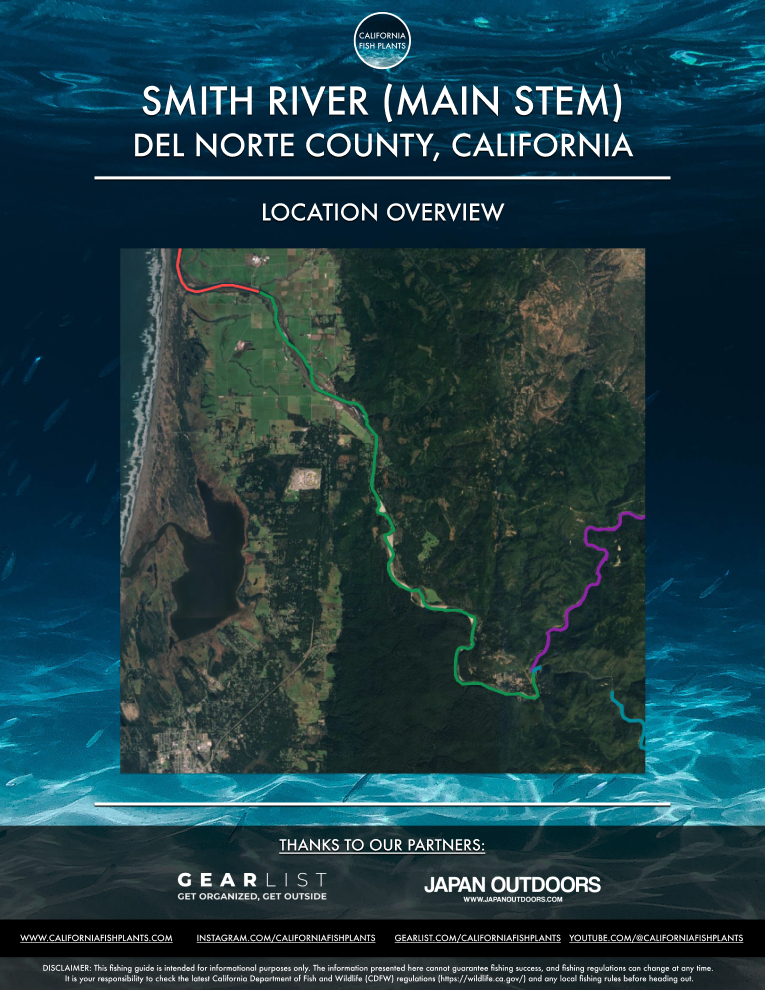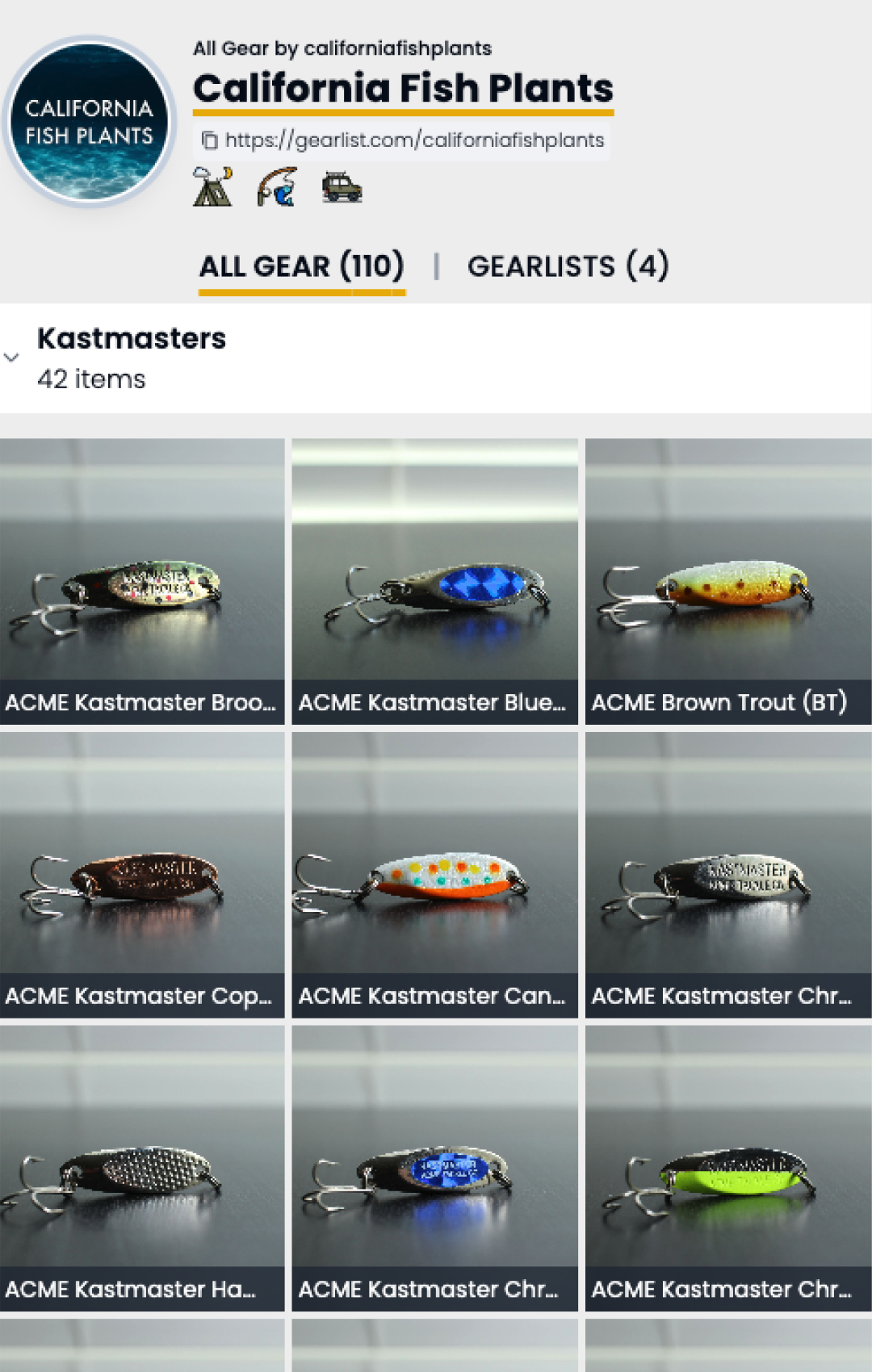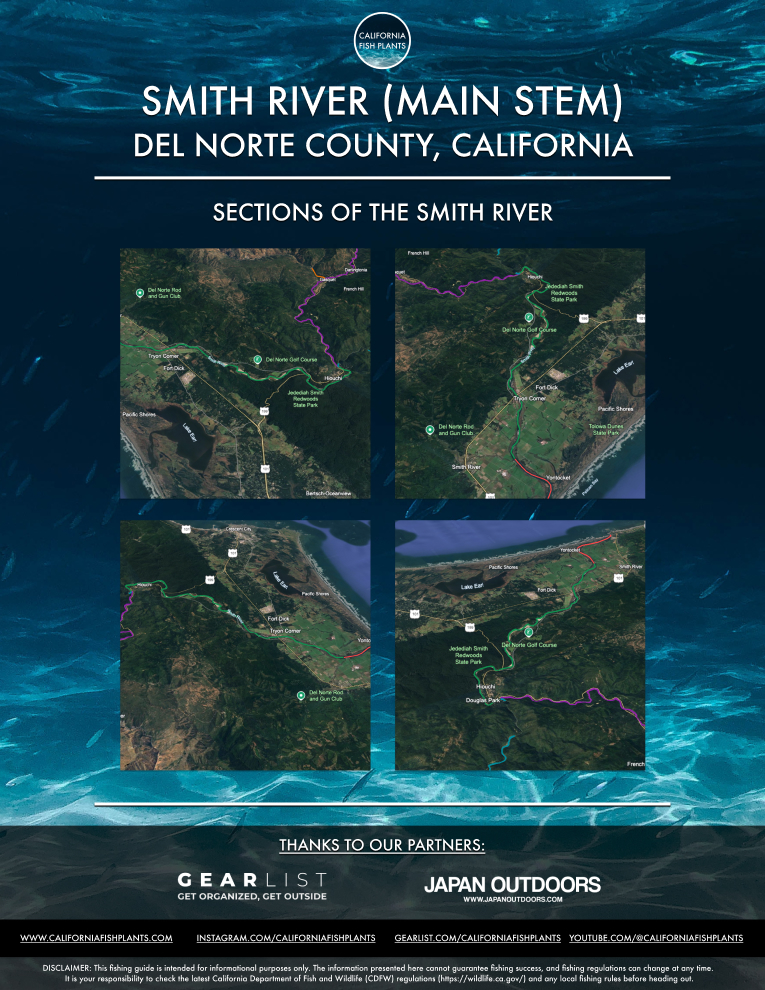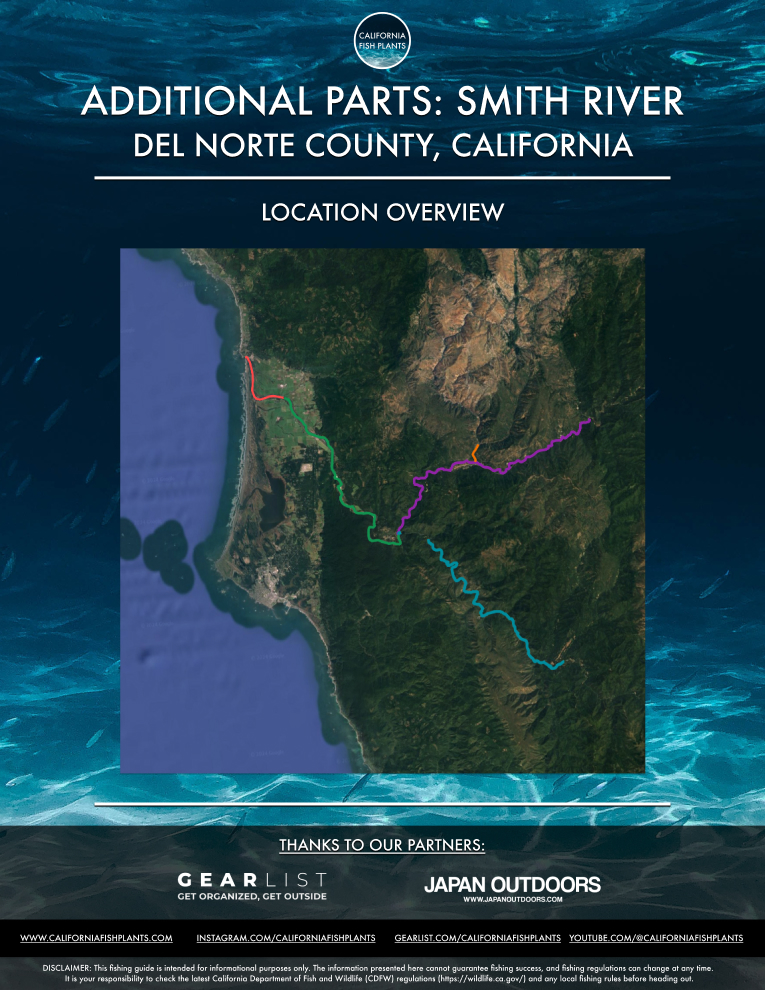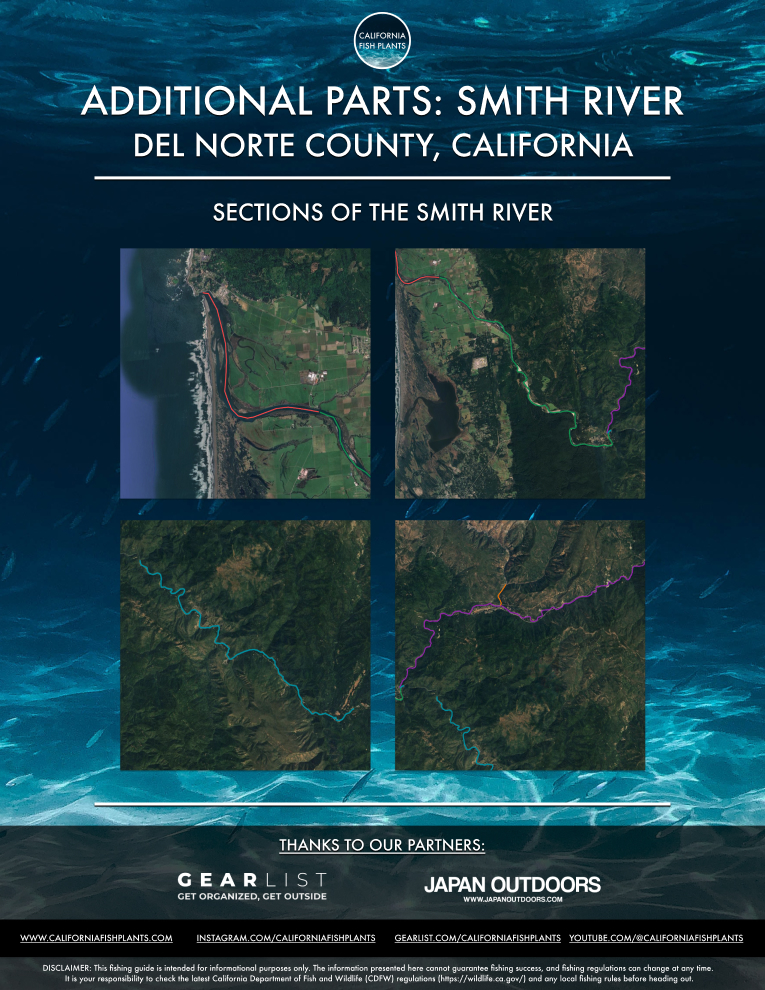The Smith River, nestled in the heart of California’s Redwood Empire, is an angler’s dream. Flowing untamed and clear through majestic redwood forests and rugged granite canyons, the river offers a sanctuary for those seeking both adventure and tranquility. As the only major undammed river in California, it remains a symbol of pure, unspoiled nature. The Smith River’s vibrant waters teem with life, offering year-round opportunities for fishing enthusiasts, whether they are seasoned pros or newcomers eager to experience the thrill of the catch.
📌 Latest Fish Reports Here
Smith River Main Stem: Scouting for Trout Hotspots Despite the Closure

We recently took a scouting trip to the Smith River’s main stem, eager to scope out some prime trout spots, even though we couldn’t fish the area due to the ongoing closure. As it stands, the river is waiting on…
📈 Latest Fish Plants
Fish here often?
How To Read Fish Plant Graphs
To interpret fish plant graphs effectively, consider the following key elements:
- Blue Vertical Bars and Numbers:
- Representation: The blue vertical bars on the graph represent individual fish plants.
- Weight Measurement: The associated numbers indicate the total weight of the plants in pounds (lbs.) that occurred during a specific week.
- Significance: Monitoring these bars helps identify weeks with higher planting activity, aiding anglers in selecting optimal times for fishing near recent plantings.
- Orange Trend Line:
- Purpose: The orange trend line represents the moving average of all fish plant activities at the specified location.
- Indicator of Activity: A rising trend line suggests a consistent increase in planting activity over the designated period. This indicates the potential for more catch opportunities and signifies a growing fish population over the weeks.
- Interpreting the Moving Average:
- Upward Trend: A rising moving average implies an upward trajectory in planting activity, indicating an increasing number of fish being introduced into the area. This suggests a positive outlook for anglers, as it implies a larger and potentially more accessible fish population.
- Downward Trend (Not Specified): The description does not provide information on the interpretation of a decreasing trend in the moving average. It might be beneficial to include information on what a decreasing trend could signify in terms of fishing prospects.
- No Data Present:
- Possible Explanations: If no data is visible on the graph, it may indicate that the location had no fish plants in the last three months. Alternatively, the absence of data could be due to non-disclosure of fish plants for that location.
- Natural Population: Some fishing areas in California rely on the natural growth of fish populations, and graphs may not show plants if this is the case.
- Graph Disclaimer:
- Data Source: The graphs reflect a combination of publicly disclosed data and estimates. Some locations may disclose fish plants without specifying exact amounts.
- Not Universal: Not all fishing areas have fish plants, and the natural growth of fish populations plays a significant role in many California fishing locations.
Understanding these elements will empower anglers to make informed decisions about when and where to fish based on historical fish plant data.
Note: If no data is present in the graph above, this location may not have had any plants the last 3 months, or may not have publicly disclosed plants. Graphs reflect both publicly disclosed data and estimates, as some locations disclose plants, but not exact amount.
🗺️ Map & Fishing Location
(click to zoom in)
New to California Fish Plants & Need an Access Code?
The Untamed Beauty of the Smith River
The Smith River’s clear, sapphire-blue waters make it one of the most visually stunning rivers in the United States. Its undammed nature means that the water flows freely, carving its way through the landscape without interference. The granite base and vast mountain watershed supply the river with pristine waters that remain clear even after the heaviest of winter rains. This unique combination of geological features ensures that the river can cleanse itself, standing resilient against the elements.
For anglers, the beauty of the Smith River is just one part of the experience. The river’s abundance of fish, from Chinook salmon to steelhead trout, offers a challenge that keeps them returning year after year. The fish populations here are robust, supported by the river’s healthy ecosystem and responsible management practices. Anglers who fish the Smith River do so knowing that they are participating in a tradition of conservation and respect for the environment.
Species to Target on the Smith River
One of the main draws of the Smith River is the diversity of fish species that call it home. Anglers can target some of the most sought-after fish in North America, including:
- Chinook Salmon (King Salmon): Known for their size and strength, Chinook are a prized catch. Their fall and winter migrations bring them into the lower reaches of the river, where they prepare to spawn. Chinook salmon are renowned for their powerful runs, acrobatic leaps, and excellent flavor. Anglers often describe the thrill of battling one of these fish as unforgettable.
- Steelhead Trout: Steelhead, the anadromous form of rainbow trout, are another key species in the Smith River. Known for their fierce fighting spirit and impressive size, steelhead migrate upstream in the spring and fall, providing anglers with multiple opportunities throughout the year. The acrobatic jumps and relentless energy of steelhead make them a favorite among experienced anglers.
- Cutthroat Trout: Native to the Smith River, the cutthroat trout offers a different kind of challenge. These trout are smaller than Chinook or steelhead, but they are no less formidable. Known for their delicate flavor and fighting spirit, cutthroat trout are most active in the spring and summer months. Anglers looking for a more technical challenge will appreciate the precision required to catch these trout in the clear, fast-moving waters of the Smith.
- Coho Salmon (Silver Salmon): While less common than Chinook, Coho salmon can also be found in the Smith River. These smaller but energetic salmon are prized for their delicious meat and their spirited runs. Coho salmon migrate upstream in the fall and winter, often overlapping with Chinook, giving anglers a chance to target both species during a single trip.
Best Fishing Practices for the Smith River
Fishing on the Smith River requires a blend of preparation, skill, and respect for the environment. To get the most out of your trip, it’s essential to come equipped with the right gear and knowledge.
- Gear Selection: For salmon and steelhead, medium- to heavy-action rods paired with 10- to 12-pound test lines are ideal. For trout, lighter tackle with 4- to 6-pound test lines will offer better sensitivity. Choosing the right gear can make or break your fishing experience, especially when battling large, strong fish like Chinook salmon.
- Fishing Locations: The Smith River’s riffles, pools, and runs offer prime habitat for fish. Riffles provide oxygen-rich water where fish can feed, while pools give fish a place to rest. Runs, which connect riffles and pools, serve as migratory routes. Knowing where to cast your line can greatly increase your chances of success.
- Lure and Bait Choices: The type of lure or bait you use can depend on the time of year and the species you’re targeting. For steelhead and salmon, spinners, spoons, and flies are effective. For trout, small jigs, minnows, and worms work best. Adapting your strategy to the river’s conditions and the behavior of the fish will help you maximize your results.
- Responsible Fishing: Catch-and-release fishing is not only encouraged but essential on the Smith River. By releasing fish that aren’t kept for consumption, anglers help maintain the river’s thriving fish populations. Properly disposing of fishing line and other waste is also crucial to preserving the pristine environment of the Smith River.
Timing Your Trip for Maximum Success
The timing of your trip to the Smith River can greatly affect your success. For salmon, October marks the beginning of the fall run. The lower reaches of the river become filled with migrating salmon, offering anglers an exciting opportunity to target these prized fish. After the first rains of the season, the river levels rise, and the salmon push further upstream, making this the ideal time to fish.
Steelhead trout offer two distinct fishing windows—spring and fall. As the steelhead migrate upstream to spawn, anglers can take advantage of their concentrated numbers in specific areas of the river. Whether you’re a seasoned steelhead angler or new to the sport, the Smith River provides an excellent environment for landing these powerful fish.
Cutthroat trout are most active during the warmer months, making spring and summer the best times to target this species. For those looking to escape the crowds, targeting cutthroat in the upper reaches of the Smith River can provide a more secluded and serene fishing experience.
Fishing Techniques for the Smith River
Given the Smith River’s clear waters, using techniques that minimize visibility to fish is key. One popular method is plunking, which involves using a heavy weight to anchor the bait in one place, often in riffles or runs where fish are likely to be moving. This method is especially effective during high water when fish are seeking stable conditions.
For those fishing in low water conditions, stealth tactics are essential. Using lighter lines and avoiding sudden movements can help you avoid spooking fish. Invisible lines like Maxima Ultra-Green are highly recommended for their ability to blend into the river’s clear waters.
In addition to traditional techniques, experimenting with fly fishing can offer a rewarding challenge. The Smith River’s diverse habitat provides ample opportunities for fly anglers to test their skills against trout, steelhead, and even salmon. For those interested in fly fishing, matching the hatch and using patterns that mimic local insects can greatly increase your success.
Gear Recommendations for Smith River Anglers
To ensure you’re fully prepared for your Smith River adventure, here are a few must-have items:
- Rods: Medium- to heavy-action rods for steelhead and salmon, and light-action rods for trout.
- Reels: Sturdy reels that match the strength of your rod, with smooth drag systems to handle long runs.
- Lines: Invisible lines like Maxima Ultra-Green to avoid detection in the river’s clear waters.
- Nets: Large, durable nets capable of landing trophy-sized fish.
- Lures and Baits: Spinners, spoons, flies for steelhead and salmon, and small jigs, minnows, and worms for trout.
For more detailed gear recommendations, including specific brands and models suited for the Smith River’s unique conditions, visit Our Gearlist.
Final Thoughts on Fishing the Smith River
The Smith River is more than just a fishing destination—it’s a place where anglers can connect with nature on a deeper level. Whether you’re targeting salmon, steelhead, or cutthroat trout, the river offers a challenge that few other places can match. From the crystal-clear waters to the towering redwoods that line its banks, the Smith River provides a backdrop of unparalleled beauty and serenity.
As you plan your next trip, remember to approach the river with respect and reverence. The Smith River is a fragile ecosystem that requires careful stewardship to ensure its continued health and vitality. By practicing responsible fishing, respecting local regulations, and staying informed about the river’s conditions, you can help preserve this natural wonder for future generations.
In the end, fishing the Smith River is about more than just the fish—it’s about the journey, the connection to nature, and the memories made along the way. Whether you land a trophy Chinook or simply enjoy the peace and quiet of the river’s remote stretches, your time on the Smith will leave a lasting impression.


